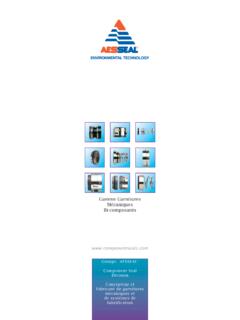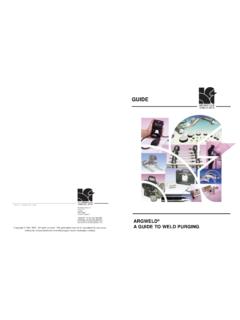Transcription of API PIPING PLANS - POLYFLON …
1 API PIPING PLANS . To check out mechanical seal flushing arrangements and PIPING PLANS , I have consistently found this to be the most useful and permanent pocket-sized document. This high-quality booklet comprehensively describes both configurational parameters and application criteria . Heinz P. Bloch Independent Professional Engineer . The API PLANS elaborated in this section are as defined by API 682 3rd edition / API 610 10th edition. These are standardized flushing PIPING arrangements that are widely used in the industry. Customer specific variants of these PLANS are possible. Please contact AESSEAL Systems division for further details. Tel: +44 (0)28 9266 9966 Email: PRIMARY FLUSH PLANS .
2 01 02 11 12 13 14 21. 22 23 31 32 41. SECONDARY FLUSH PLANS . 51 61 62. CONTAINMENT SEAL PLANS . 65 71. GAS SEAL PLANS . 72 74. Conserve Water . Of all the worlds water is salt water, 2% is solid in ice caps and only is suitable for industrial use and human consumption.. PRIMARY FLUSH PLANS . 01. Internal drill for recirculation API plan 01. Description Integrated (internal) product recirculation from pump discharge to seal chamber. Features 1. Minimizes risk of freezing / polymerizing of fluid in flush PIPING PLANS exposed to atmosphere. 2. Removes heat from the seal chamber as well as acting as a vent connection in horizontal pumps. Use 1. Recommended in clean fluids. 2. Recommended for fluids which thicken at ambient temperature.
3 Caution 1. Ensure that the recirculation is sufficient for seal heat removal. 02. API plan 02. Description Dead ended seal chamber with no flush fluid circulation. Features 1. Applicable to low seal chamber pressure and process temperature. 2. Can be used with tapered seal chambers, especially for slurries. 3. Normally is used along with a jacketed seal chamber. Use 1. In cool clean fluids with high specific heat, such as water, in relatively low speed pumps. Caution 1. To avoid flashing, process fluid temperature must be taken into consideration. 2. Avoid use without cooling / heating jacket (for cylindrical chambers). 3. Ensure top point vent in throat bush (for cylindrical chambers in horizontal pumps).
4 11. Flow control orifice API plan 11. Description Product recirculation from pump discharge to seal through a flow control orifice. Features 1. Prevents product from vaporizing by maintaining positive pressure above vapor pressure. 2. Becomes a self-venting plan for horizontal pumps. 3. Default API plan for most single seals. Use 1. In general, applications with clean non-polymerizing fluids with moderate temperatures. Caution 1. Calculation of recirculation flow rate, heat removal and orifice size are required. 2. Orifice size should be at least 1/8 ( ). 3. Check the margin between discharge pressure & seal chamber pressure to ensure proper flow of fluid. 4. Do not use with media containing solids & abrasives.
5 12. Y strainer Flow control orifice API plan 12. Description Product recirculation from pump discharge through a Y strainer and a flow control orifice to seal chamber. Features 1. Becomes a self-venting plan for horizontal pumps. 2. Can handle dirty liquids to some extent. Use 1. In general used in slightly dirty and non-polymerizing fluids. Caution 1. Always ensure that orifice is placed after the Y strainer. 2. This plan is normally discouraged due to non-reliability of Y strainer. 3. Calculation of recirculation. 13. Flow control orifice API plan 13. Description Product recirculation from seal chamber to pump suction via a flow control orifice. Features 1. Provides continuous vent for vertical pumps.
6 Use 1. Wherever plan 11 is not usable due to low-pressure margin between discharge & seal chamber pressure. 2. Used in vertical pumps. Caution 1. Check margin between seal chamber pressure & suction pressure. 2. Orifice size should be at least 1/8 ( ). 14. Flow control orifice API plan 14. Description Product recirculation from pump discharge to seal chamber through a flow control orifice and seal chamber back to suction through another flow control orifice. Features 1. Ensures product recirculation as well as venting. 2. Reduces seal chamber pressure. Use 1. Used in vertical pumps. 2. Used in light hydrocarbon services. Caution 1. Check for pressure margin between discharge to seal chamber pressure and seal chamber to suction pressure.
7 21. Flow control orifice Cooling water out Heat exchanger Cooling water in Temperature indicator T. API plan 21. Description Product recirculation from discharge through flow control orifice and heat exchanger to seal chamber. Features 1. Improves pressure margin over vapor pressure. 2. Improves temperature margin to meet secondary sealing element limits, to reduce coking or polymerizing & to improve lubricity. 3. Self venting plan . 4. Provides sufficient pressure difference to allow proper flow rate. Use 1. For high temperature applications hot water application (temperature > 80 C), hot hydrocarbons etc. 2. In hot non-polymerizing fluids. Caution 1. Always ensure that cooler is placed after the orifice.
8 2. Check pressure difference between discharge and seal chamber. 3. Cooler duty is high leading to fouling on waterside. 4. Potential plugging on process side if fluid viscosity gets high quickly. 22. Flow control orifice Y strainer Cooling water out Heat exchanger Cooling water in Temperature indicator T. API plan 22. Description Product recirculation from pump discharge through a Y strainer, a flow control orifice and a heat exchanger to seal chamber. Features 1. Improves pressure margin over vapor pressure. 2. Improves temperature margin to meet secondary sealing element limits, to reduce coking or polymerizing & to improve lubricity. 3. Self venting plan . 4. Provides sufficient pressure difference to allow proper flow rate.
9 Use 1. For high temperature applications with slightly dirty liquid. Caution 1. Always ensure that cooler is placed after the orifice. 2. Check pressure difference between discharge and seal chamber. 3. Cooler duty is high leading to fouling on waterside. 4. This plan is normally discouraged due to non-reliability of Y strainer. 23. Cooling water out Heat exchanger Cooling water in Temperature indicator Pumping T. ring API plan 23. Description Product recirculation from seal chamber to heat exchanger and back to seal chamber. Features 1. Circulation is maintained by pumping ring. 2. In idle condition heat transfer is maintained by thermosyphon effect and in running condition by a pumping ring.
10 3. Lower product stabilization temperature is achieved. 4. Establishes required margin between fluid vapor pressure and seal chamber pressure. Use 1. In hot and clean services in boiler feed water and hot hydrocarbon services. Caution 1. Maintain maximum horizontal distance from seal chamber to heat exchanger. 2. Vent valve required at highest point of PIPING system. 3. Ensure that pump has a close clearance throat bush. 4. Ensure that the seal outlet connection is in the top half of the gland. 5. Ensure that the cooler is mounted above the pump centre line. 6. Vent the system fully before start up. 31. Cyclone Separator Clean mechanical seal flush fluid Product return to pump suction API plan 31.



